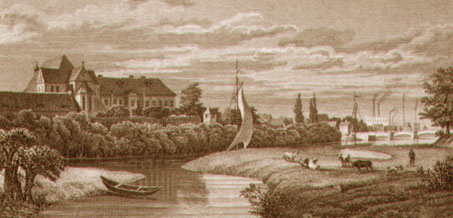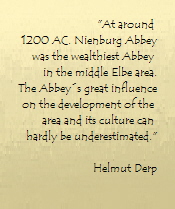

|
Expansion of the Christian/occidental culture east of the rivers Saale, Elbe and Neisse. |
|
Towards the end of the 1st Millennium AC. Nienburg Castle was a border fortress in the Holy Roman Empire of the German People. |
|
In 975 AC. Archbihop Gero of Cologne and his brother Margrave Thietmar moved the Benedictine Abbey inside the keep of the Nienburg Castle. They had founded the Abbey 5 years earlier in Thankmarsfelde in the Harz Mountains. Emperor Otto II. had agree this move and raised its status to a free Imperial Abbey. Otto II. as well as many other roman emperors and the pope provided it with many privileges and generous donations. |
|
The choice of location was driven by the aim to introduce Christianity to an area mainly inhabited by the Wends. Wends or Slavs (Sorbs) had migrated into the area during preceding centuries bringing their pagan religion with them and turning the balance in the middle Elbe area in their favour. |
|
1. Rise |
|
2. Heydays |
|
3. Fall |
|
The Benedictines worced by cultivating both soil and mind. They acted with tolerance and leniency, promoting art and science. Nienburg Abbey has remained the centre of artistic and scientific endeavours throughout its history. |
|
Next . . . you will learn about the heydays of the Abbey. |
|
1. Rise |
|
2. Heydays |
|
3. Fall |
Translated into English by D. Niklas, London
english




|
|

